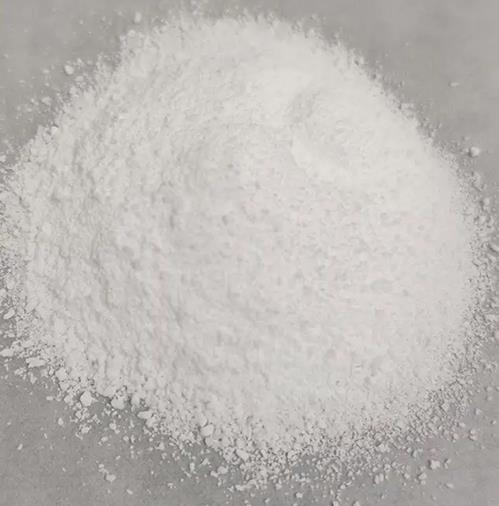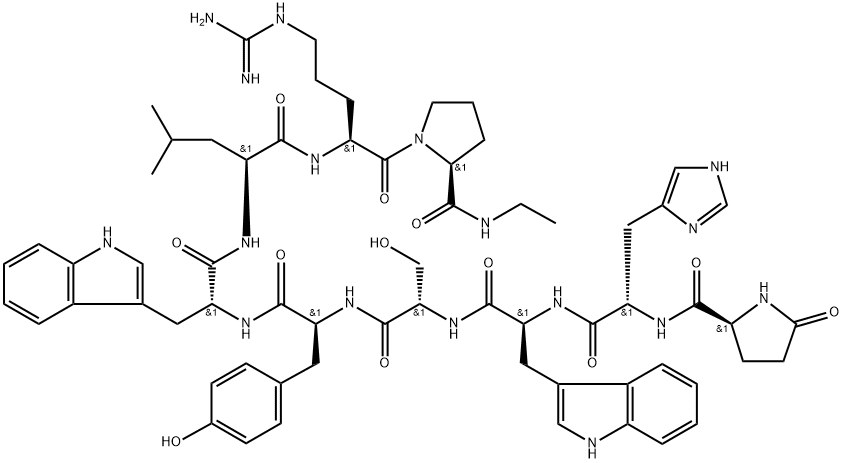The use of Deslorelin in different animals
Introduction
Deslorelin(Figure 1) is a gonadotropin-releasing hormone (GnRH) agonist used in different species with opposite effects on reproductive function. Continuous release of an exogenous GnRH agonist, such as by subcutaneous implant, can lead to the pituitary down-regulation of GnRH receptor, thus reducing gonadotrophin and reproductive hormone release. As a consequence, gonadal activity is blocked and sexual and aggressive behaviors are reduced.[1]

The 4.7 mg deslorelin implant is registered under the brand name Suprelorin in the European Union (EU), Australia and New Zealand for the long-term suppression of fertility in adult male dogs. The EU and Australia have further registered the 9.4 mg implant for chemical castration of adult male dogs and adult male ferrets; Australia has additionally approved the implant to manage hyper-adrenocorticism in ferrets.(Suprelorin® F, a 4.7mg deslorelin implant, is available in the United States as a Food and Drug Administration Indexed Product to manage adrenal disease in sterilized and sexually intact male and female ferrets.) Suprelorin 9.4 mg contains a double dose of deslorelin and a matrix without the excipient sodium acetate anhydrous to allow for a longer duration of infertility.As the GnRH amino acid sequence is highly conserved and as desensitization always occurs following continuous exposure to GnRH agonists (such as deslorelin), several research teams have investigated the potential of deslorelin to control reproduction and/or to prevent or suppress sex hormone-related behavior and disease in male and female cats.[2]
Physiological feasibility
The ease of administration, efficacy, safety and reversibility of deslorelin implants explain why they are perceived as a promising method for controlling male and female domestic cat reproduction; in particular by the owners of cats temporarily not intended for breeding, but also by veterinary practitioners for cats at increased anesthetic risk and by organizations in areas without easy access to a surgical facility.In most feline studies published in the scientific literature, deslorelin implants are inserted subcutaneously through a needle between or in the region of the shoulder blades. If easy removal of the implant is desired (eg, in an attempt to shorten the duration of action), the implant may also be inserted into the umbilical area. Anesthesia or sedation are not required.[2]
Deslorelin studies in cats
Slow-release deslorelin implants have been shown to generate effective, safe and reversible long-term contraception in male and female cats. In pubertal cats, a 4.7 mg deslorelin implant suppressed steroid sex hormones for an average of approximately 20 months (range 15-25 months) in males and an average of approximately 24 months (range 16-37 months) in females. Reversibility has been demonstrated by fertile matings approximately 2 years post-treatment in both male and female adult cats. In prepubertal female cats of approximately 4 months of age, puberty was postponed to an average of approximately 10 months of age (range 6-15 months) by a 4.7 mg deslorelin implant. The large variability in the duration of suppression of gonadal activity makes the definition of the optimal time for reimplantation quite challenging. In addition, the temporary stimulation phase occurring in the weeks following deslorelin implantation can induce in adult female cats a fertile estrus that needs to be managed to avoid unwanted pregnancy. Longer duration and larger scale controlled field studies implementing blinding, a negative control group and a carefully controlled randomization to each group are needed. Furthermore, the effects of repeated treatment need to be investigated. Finally, the effect of treatment on growth and bone quality of prepubertal cats needs to be assessed. However, the ease of use, long-lasting effects and reversibility of deslorelin implants are strong positive points supporting their use for controlling feline reproduction.[2]
Deslorelin in Oryx dammah males
The aim of this study was to assess the effects of the deslorelin subcutaneous implant as a temporary contraceptive method in the Oryx dammah male. For this purpose, deslorelin at different doses, i.e. 14.1 mg and 9.4 mg, was subcutaneously implanted in three males (Phase 1) and one male (Phase 2) adult Oryx dammah, respectively. Quantitative behavior evaluation and androgen concentrations in feces and plasma were assessed before and after implant application. Fecal androgen concentrations observed in treated males were compared with those measured in one orchiectomized male and two females. Fecal androgen concentrations increased up to 15 days after the implant application, then progressively decreased, reaching the basal level at day150 in Phase 1. In Phase 2, levels remained high until day 60 and returned to basal level on day 120. Plasma testosterone concentration was higher on the day of implant application than three months later, but with variable ranges among males. A general increase of activity levels and hierarchical changes were observed after treatment, in accordance with hormonal variations. Despite males cohabiting with two fertile females during the observation period, no births were recorded. However, between the end of Phase 1 and the beginning of Phase 2, i.e. about 10-11 months after the first deslorelin implant, a fertile mating occurred leading to the birth of a calf. Therefore, we can hypothesize a contraceptive effect up to 10 months after the implant. Testicular histology performed on one male at the end of the Phase 2 showed no spermatogenetic activity. Our results suggest that deslorelin implant can be used to temporarily control reproduction in the Oryx dammah male. Behavior and fecal androgen measurements were useful and repeatable, non-invasive methods to monitor response.[3]
Deslorelin in Male Rhesus Macaques (Macaca mulatta)
Sterility in male NHP has long been achieved through surgical castration or vasectomy. However, these techniques are irreversible, require a surgical procedure, and have potential consequences such as sperm granulomas and long recovery time. Deslorelin is a gonadotropin-releasing hormone agonist that temporarily and reversibly suppresses sex hormone secretion. The goal in this study was to investigate the effects of deslorelin on testosterone secretion and testicular volume in male rhesus macaques (Macaca mulatta). Male macaques (n=4) each received two, 4.7-mg deslorelin implants subcutaneously in the interscapular region. Serum testosterone and testicular volume were then monitored at specific time points until 10 mo after treatment. Testosterone suppression was defined as testosterone levels lower than 0.6 ng/mL for a sustained period of at least 30 d. After implantation, mean testicular volume was significantly reduced by day 121. Testosterone suppression was observed in all subjects. However, the time from implantation to testosterone suppression and duration of suppression varied. Two macaques were hormonally suppressed by day 26 after implantation and remained suppressed for at least 6 mo. The other 2 macaques were hormonally suppressed by 2 mo after implantation; of these two, one remained suppressed for 70 days while the other was suppressed for at least 245 days. Tran et al. had concluded that deslorelin can safely suppress testosterone secretion in male rhesus macaques, but individual variation in onset and duration of action should be considered when establishing reimplantation time points and potential return to reproductive activity.[4]
References
1.Bonacina E, Negri G, Mattiello S, Gabai G, Groppetti D. Deslorelin subcutaneous implants in Oryx dammah males for reproductive control. Theriogenology. 2020;149:72-78. doi:10.1016/j.theriogenology.2020.03.018
2.Fontaine C. Long-term contraception in a small implant: A review of Suprelorin (deslorelin) studies in cats. J Feline Med Surg. 2015;17(9):766-771. doi:10.1177/1098612X15594990
3.Bonacina E, Negri G, Mattiello S, Gabai G, Groppetti D. Deslorelin subcutaneous implants in Oryx dammah males for reproductive control. Theriogenology. 2020;149:72-78. doi:10.1016/j.theriogenology.2020.03.018
4.Tran HD, Carroll KE, Mackiewicz AL, et al. Effects of Deslorelin on Testosterone Secretion and Testicular Volume in Male Rhesus Macaques (Macaca mulatta). J Am Assoc Lab Anim Sci. 2023;62(6):525-530. doi:10.30802/AALAS-JAALAS-22-000116
You may like
Lastest Price from Deslorelin manufacturers

US $1.00/KG2025-04-21
- CAS:
- 57773-65-6
- Min. Order:
- 1KG
- Purity:
- 99%
- Supply Ability:
- 10 mt

US $0.00/g2025-04-21
- CAS:
- 57773-65-6
- Min. Order:
- 1g
- Purity:
- 0.99
- Supply Ability:
- 1000kg


